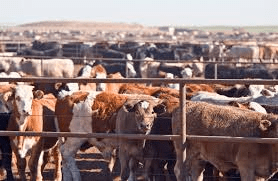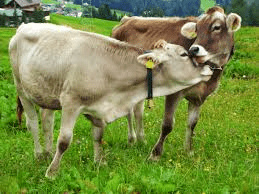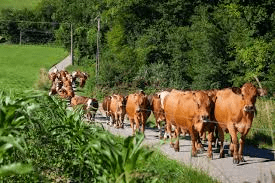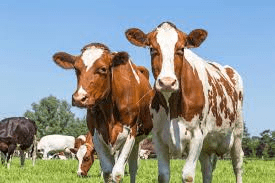In livestock farming business, Ruminant farmers usually raise questions like where is one supposed to put their drugs, is it in their feeds or water?
This is a very simple question for most ruminant farmers those into livestock farming business who are aware of the answer and at the same time a very difficult question for those that are not aware of the answer. Normally, this depends on the route of administration of the drugs and they are usually stated on the drugs to be used.
If the drug is an oral drug, definitely it will be given to them through their water or their feeds but if it injectable (the type of drug that must be injected into the animals body), it will either be in the muscles or veins.
Therefore, there is no fixed route of administration for ruminant animal drugs. In fact and most importantly, your consultant should determine the route of administration of drugs so it is always advisable to carry the person along for proper guidance.
Read Also: How to Identify the Particular Disease Affecting your Ruminant Animals
Livestock Farming: Proper Injection Techniques in Dairy Cattle

1) Selecting the drug, dosage and injection technique
- Consult a veterinarian and read the medication label and/or package insert before vaccinating animals.
- Administer only drugs labeled for use in dairy cattle. Refer to the vaccine label for this information. Using a vaccine in an animal species for which it is not labeled is illegal.
- Give the proper dosage as indicated on the label.
- Always give an injection in the body area recommended on the product label. Give injections forward of the shoulder when possible. The neck muscle is the best choice.
- Avoid placing more than one injection on the same side of the neck to prevent medicine interactions and severe tissue reaction.
- Don’t inject more than 10 cc (ml) in one site. If more medication must be given, use several injection sites.
- Use the recommended route of administration. There are three main routs of administration.
- Subcutaneously (SQ). This injection goes between the skin and muscle, but not into the muscle. Many vaccines and antibiotics can be administered this way. It is the preferred method for protecting meat quality. Always use this method if it is an option given on the label.
- Intramuscularly (IM). This injection goes directly into the muscle. To minimize damage to meat, use the muscles in front of the shoulder.
- Intravenously (IV). This injection goes into a vein and directly to the animal’s blood stream. It is used for medications that can cause severe muscle damage. In dairy cows, the mammary vein can be used for IV injections. But use this vein only if a veterinarian recommends it and shows you how to do it.
- Give boosters when required.
2) Selecting equipment
- Use only clean, sharp needles, preferably new ones.
- Use the appropriate needle size for the medication being administered. Needles usually range from 16- to 18-gauge and from 1 to 2 inches long. Use the smallest size needle that will work.
3) Handling animals
- Restrain animals properly before vaccinating them.
4) Handling vaccines
- Always note the expiration date and instructions for storage on the medicine label.
- Most vaccines must be refrigerated during storage and use. Keep the refrigerator temperature between 36 degrees F and 46 degrees F.
- When using vaccines, keep them in an insulated cooler with ice packs during the summer.In cold weather, use the same container to keep vaccines from freezing. Freezing makes some vaccines ineffective.
- If vaccines do not require refrigeration, store them out of direct sunlight and in a controlled environment.
- When finished vaccinating for the day, properly dispose of any remaining vaccine. Once a vaccine vial is opened, the expiration date is void.
5) Using sanitary methods
- Protect needles and medicines from dust. Dust particles injected with a medicine can cause abscesses.
- Use a transfer needle to extract medicine from the bottle and transfer it to another needle used for the injection.
- Never insert a used needle into a medicine bottle. Use a clean needle or a transfer needle.
- Use a clean needle for each animal to prevent the transmission of disease.
- Do not use chemical disinfectants to sterilize needles or syringes. Instead, place them in boiling water for 20 minutes.
- Properly dispose of used needles in a puncture-proof “sharps” container.
6) Timing injections and observing withdrawal periods

- Avoid vaccinating cows within 2 weeks of calving.
- Pay attention to withdrawal times listed on product labels. The amount of time required after a medicine is administered before the meat and/or milk are safe for consumption is called the withdrawal time. The withdrawal times for meat and milk may be different. It is illegal to sell meat or milk that contains medicine residue and sellers are subject to large fines.
- If there is a withdrawal time on the label of the drug you are using, mark the animal with a leg band or some other identification.
7) Keeping records
- Develop a record-keeping system for your dairy herd to document individual animals or groups
of animals treated. Be sure to record:- Date of treatment
- Name, lot number and serial number of the product used
- Route of administration
- Also record the success or failure of the treatments and any unusual side effects or reactions observed in animals.
8) Preventing injection site lesions
When an injection is done improperly or the injection site becomes infected, the result may be tissue damage and abscess.An abscess is an accumulation of dead cells in the tissue. Abscesses reduce carcass quality and the price the producer receives.Injection site scarring also reduces carcass quality.
In fact, most quality defects in meat from dairy carcasses are a result of injection site scarring, which can radiate up to 3 inches from the injection site into surrounding muscle tissue. Even very young calves can form injection site lesions, and these lesions may remain until slaughter.
The best way to prevent abscesses and scarring is to administer vaccines subcutaneously whenever possible. When intramuscular injections must be given, be sure to use proper injection techniques.
Read Also: Signs and Diseases Ruminant Animals (Livestock) get from Feeds and Water
Livestock Farming: Drugs for livestock treatment


1) Drugs for livestock farming treatment
Drugs for livestock care
Drugs are allowed in organic farming as per veterinary recommendations but alternative medicine is preferred. Preventive use of drugs is forbidden and antibiotics can be used a limited times, with a double withdrawal time. Animal health care is still not sufficiently developed that we can keep livestock healthy without veterinary drugs.
In Europe and the USA great progress has been made towards the use of homeopathic veterinary medicine which in many instances has shown its applicability to certain health problems.
In Africa ethnoveterinary solutions are also commonly used and to some extent may be effective where an experienced herbalist has been consulted. Much of this is not well documented and verified as effective but a lot of farmers use it with good results.
Livestock farming Vaccines
In order to keep livestock healthy it is very important to observe strict adherence to recommended vaccination schedules recommended by your veterinarian, who should be familiar with the kind of diseases occurring in your area.
Vaccines are active or inactivated disease organisms used to boost immunity of the livestock from specific diseases. They have played a major role in eradicating some of the most dangerous diseases both in man and livestock such as smallpox in man and rinderpest in animals.
Application of vaccines is a cheap way of protecting your whole flock against devastating diseases, such as Newcaste disease, which cannot be treated and can kill all the chicken in an entire village.
Another example of a deadly disease which can kill all your goats and half of your sheep is Goat Plague or Pest of small ruminants (PPR); there is no treatment against PPR but it can be prevented by vaccination.
Keeping up to date on which vaccinations are important for success of livestock in your area is a very important management tool.
Vaccines need to be kept constantly chilled in a fridge or frozen (depending on manufacturers instructions), as they deteriorate rapidly and loose efficacy within hours when exposed to warm temperature.
New, so called ‘thermostable’, vaccines are becoming available, which are more resistant to warm temperatures and can be kept for days (sometimes weeks) without cooling or freezing. Once a vaccine vial has been opened the whole contents should be used quickly.
Unused vaccine remaining in the open vial cannot be kept for later use. It is advisable for several farmers to team up and have their animals vaccinated together on the same day. In this way they will share the costs for buying the vaccine, make full use of the vaccine vial contents and the vaccination becomes cheaper.
In Kenya vaccines are available from KEVEVAPI, Coopers Ltd, or a well stocked local veterinary shop equipped with a fridge. Vaccines should be handled and administered by trained veterinary personnel. Most often you will have to rely on the local veterinarian for vaccinating your animals.
Chicken vaccination by eye-drop against Newcastle disease can be administered by trained farmers.
Read Also: Layers or Broilers which One is More Profitable in Poultry Farming? Find Out!
Basic Livestock Farming Medicines to keep in stock
As Kenya and East Africa in general has a very low population of trained veterinarians, farmers need to learn to deal with emergencies that happen when the vet is not around.
Most environments in Africa have a high disease challenge, and the serious farmer need to learn how to deal with this in order to have healthy, happy and productive animals. Below is a list of some of the most useful medicines to keep in the store and use in such emergencies:
Treatment of hoof rot with Formalin
(c) William Ayako, KARI Naivasha
Medicine for Livestock farming
To be used for in Livestock farming
Iodine solution and Iodine ointment
Wound treatment
Hydrogen Peroxide solution
Cleaning and flushing wounds
Surgical spirit
Disinfection of skin and also of your hands (e.g. before assisting with birth)
Antibiotic intra-mammary tubes
Treating wounds and skin infections
Injectable Tetracycline or Penicillin solution
Treating infections where the animal has fever. By Kenya law farmers are NOT allowed to use such drugs, but are required to call a qualified veterinarian to administer the treatment.
Sulphonamide powder for giving by mouth
Treating diarrhoea in suckling animals
Antibiotic for the uterus (Bolus)
Treating retained placenta
Bloat medicine – or cooking oil
For treating bloat – link to Bloat
Glucose or sugar or honey and household salt
Rehydration fluid to treat animals with diarrhoea
Drug against ticks (Acaricide)
To treat the skin of animals against ticks and also against mange
Magnesium sulphate
Constipation and poisoning
Epsom Salt
Antiseptic/also to treat abscesses externally
Vitamin B
Treating anemia, poisoning
Multi vitamin injection
Strengthens recovering animals
Worm medicine (Anthelminthic)
Treat worm infections
Crushed charcoal
For poisoning and colic cases
Copper sulphate, Formalin or Blue Spray
For foot rot
Stockholm tar
To treat wounds on the hooves and to cover skin lesions
Table adapted from Forse 1999
2) Drug withdrawal periods
Veterinary drugs contain substances, which are potentially toxic and harmful to humans. After giving a drug to an animal these substances remain in the animals’ body for some time until they have been completely excreted. While these toxic substances remain in the body they can be found in the muscle (meat) and also in the udder (milk).
A person consuming meat or milk from an animal that still has drug substances in its body will ingest harmful and toxic substances. To prevent this from happening drug manufacturers provide a withdrawal period for each drug. The withdrawal period is the time until all toxic and harmful substances have been cleared from the body (including from meat and milk) of the treated animal.
If more than one injection has been given the withdrawal period begins after the last treatment. Before the withdrawal period is over, milk from the treated animal must not be consumed and the animal can also not be slaughtered for meat. For meat the withdrawal period may be longer than for milk.
3) Estimation of live weight and correct dosing
Drug dosage depends entirely on the animals body weight. Whereas most farmers do not have access to weighing scales that can weigh animals, the body weight of cattle (and pigs) can be determined by chest measurements using a simple measuring tape available from Agro-Vet shops.
Drug manufacturers provide dosage information, which is normally in ml (or cc) per kg body weight. Once the body weight of an animal has been estimated (in full kg), the drug dosage is calculated according to the manufacturers instructions.
All drugs have a safety margin, so slight overdosing does not do any harm. But giving a too low dose can lead to treatment failure. Round up the volume of the drug to full ml (or cc) according to the calibration of the drench-gun or syringe.
Estimation of live-weight of dairy cattle using chest girth measurements

Dosage Examples:

Read Also: 7 Factors to Consider before Setting Up your Farming Business
4) Under dosing of drugs and drug resistance
The dosage for a drug provided by the manufacturer ensures that the amount of the drug in the body of the treated animal is high enough to kill all bacteria or parasites causing disease. Because drugs spread to all parts of the body large heavy animals need more of the drug than light small animals.
When administering less than the recommended dose the strength of the drug inside the body is low and kills none or only some of the bacteria/parasites. This is called underdosing – giving too little of the drug.
The result of underdosing is either no cure, or an incomplete cure where the animal first improves but then relapses. To make matters worse, the remaining bacteria/parasites learn how to survive the drug and become resistant.
So even when a full dose of the drug is applied later, these resistant bacteria/parasites are not killed and continue to cause disease inside the animal. This is called drug resistance. The drug no longer works.
It is the same when treating worms inside the stomach and intestines. Large animals have bigger guts and need more of the dewormer. Because underdosing is very common in deworming, some anthelmintics/dewormers no longer work and farmers have serious problems deworming their livestock.
To avoid the problem of drug resistance correct dosage, according to manufacturers? instructions must always be followed.
A veterinary laboratory can check whether a particular drug or dewormer is effective or whether you have resistant bacteria/worms in your herd. Based on the lab results the best choice of drug for your livestock (e.g. for treating mastitis or worms) can be identified.
Read Also: Impact of Forest and Wildlife Policy on the Society
Frequently Asked Questions
We will update this section soon.

